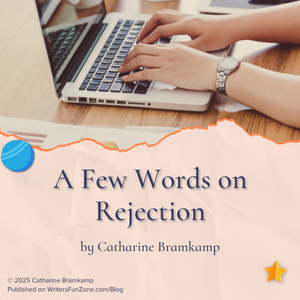A Few Words on Rejection by Catharine Bramkamp
 Let’s welcome back monthly columnist Catharine Bramkamp as she shares with us “A Few Words on Rejection.” Enjoy!
Let’s welcome back monthly columnist Catharine Bramkamp as she shares with us “A Few Words on Rejection.” Enjoy!
***
No one wants to be voted off the island, but rejection is an unavoidable part of the publication process.
No matter your effort, no matter how well you studied the market and courted the perfect literary magazine for your story, you risk a no.
For some writers, that is a tremendous risk. For others, it is just another step on their journey.
Failure has a Bad RapFailure has a bad reputation.
When we think of failure, we automatically imagine that odd uncle who lost his job in 1975 and never found another. No one wanted to sit next to him at Thanksgiving dinner. Your parents tutted, he was such a failure, poor Marie.
That kind of impression stays with a girl.
On the other hand, failure is how we discover what doesn’t work – the propeller on a plane, the plot of a novel, the twist at the end of a stand-up routine, which shores are dangerously rocky.
Feel the failure. Feel sad.
Then, pick up the pieces and, if possible, apply the hard-won information to your next attempt.
After spending a whole lot of years deep in this learning cycle, I’m delighted to find that rejection doesn’t affect me as strongly as it did when I was younger.
Perhaps because I know more about how the publishing business works.
Perhaps because I have more lovely, successful activities in my life than just publication.
Which is key.
I wouldn’t bring this up if I didn’t have a rejection story to tell.
The Rejection ExperienceI serve on the board of a local Arts Council.
One wonderful year, the State of California issued a grant program for artists, and our council oversaw a small amount of money (about 4 million) to distribute to artists and their projects across nineteen counties.
The counties in California are large.
Hundreds of artists applied for project grants, including me.
The criteria were quite specific, and we were to create art that would improve state metrics, such as health, housing, and social responsibility. Which is a lot to ask of a sculpture of egg cartons and twine, but those were the rules.
I did my best, submitted my project by the March deadline.
In April, my mother passed away.
In June, we held her celebration of life and went to Ireland for three weeks, where I immediately began a Bloomsday project. (On June 16th, Dublin celebrates hometown author James Joyce.)
I received news in Dublin that my project would not receive funding.
I was sorry, but Guinness.
Fast forward two years — the grant programs were wrapping up.
I enjoyed hearing about the funded projects, the creativity, and imagination it took to make a positive impact on their community. I hoped these grants would launch these artists into a new creative phase, along with increased recognition for their work.
The Rejection TurnaroundInterestingly, that same week, I learned that a popular local artist, who, like me, had not received the grant, was still angry.
Two years.
Still mad.
It’s just a grant.
The process was incredibly complex, and the competition was fierce.
What was her problem? Did her husband leave her for that adorable checker at Safeway?
Now that is a rejection worth stewing over for two years.
How to View RejectionOne can view rejection as just another road sign. And it’s easy to avoid those road signs if you never climb into a car, but you won’t get anywhere.
I know artists who have convinced themselves that their work is just too interesting and brilliant for this sordid world of commerce and lucre.
Or, like our angry local artist, thinking she should get opportunities because, well, she is here, and she is an artist, what more do you need?
A well-written grant application.
How to Embrace The ProcessThe afternoon my clients send off their manuscript to an agent, or an indie publisher, or a contest, I recommend that they start a new project the next morning.
Stay in the game.
Keep a list of two or three engrossing projects you want to dive into, and start one.
We earn our joy from indulging in the process, because it’s about the challenge, the travel, the research — everything that builds our book. If we can emphasize that, then rejection will no longer be an issue.
Keep writing, and you can stay on the island with the rest of us.
Need your help! I’m writing a book on creativity, and I need your input.
Please take this short creativity survey, and your story may be featured! Due July 1, 2025 — Thanks!
***
Want to read more articles like this one Writer’s Fun Zone? Subscribe here.
***
ABOUT THE AUTHOR Catharine Bramkamp is a successful writing coach, Chief Storytelling Officer, former co-producer of Newbie Writers Podcast, and author of a dozen books including the Real Estate Diva Mysteries series, and The Future Girls series. She holds two degrees in English and is an adjunct university professor. After fracturing her wrist, she has figured out there is very little she is able to do with one hand tied behind her back. She delights in inspiring her readers.
Catharine Bramkamp is a successful writing coach, Chief Storytelling Officer, former co-producer of Newbie Writers Podcast, and author of a dozen books including the Real Estate Diva Mysteries series, and The Future Girls series. She holds two degrees in English and is an adjunct university professor. After fracturing her wrist, she has figured out there is very little she is able to do with one hand tied behind her back. She delights in inspiring her readers.
The post A Few Words on Rejection by Catharine Bramkamp appeared first on Writer's Fun Zone.



